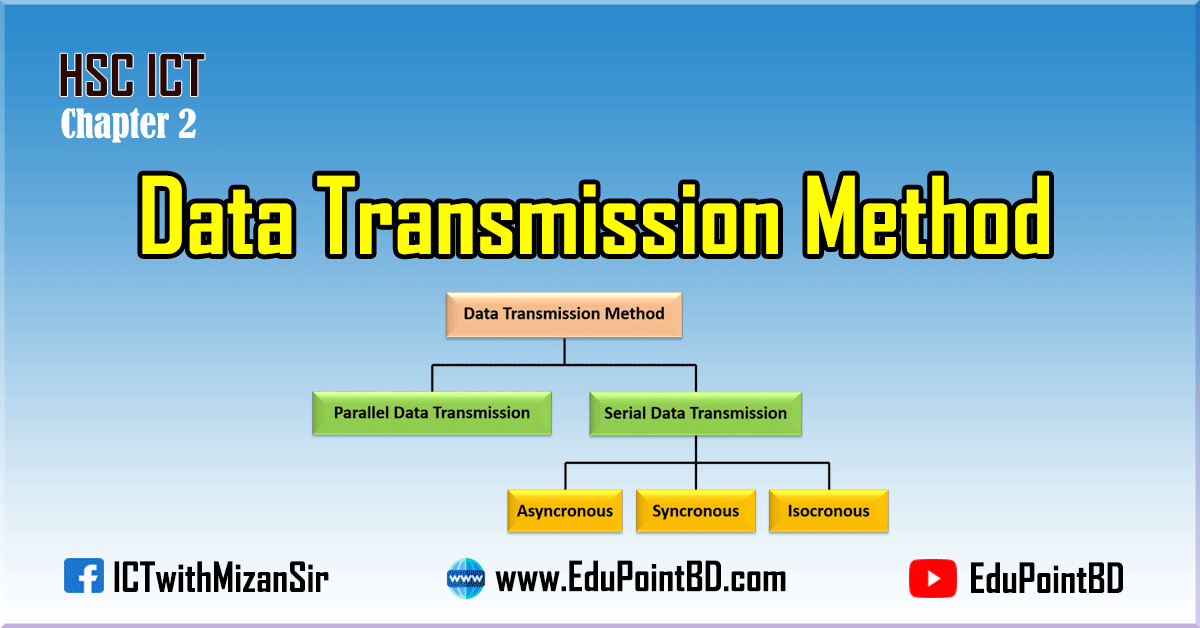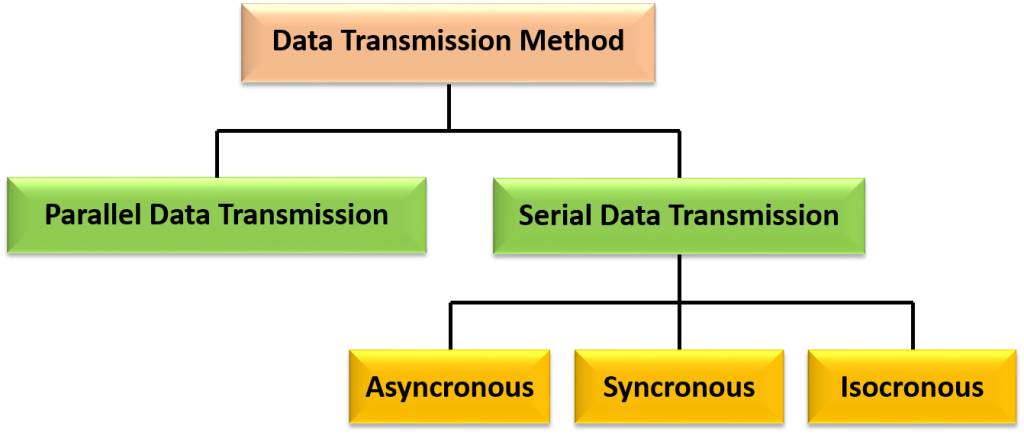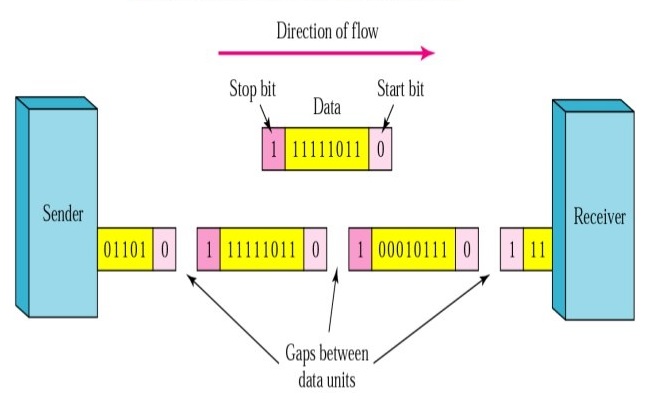
At the end of this lesson-
1. You will be able to explain the concept of data transmission method.
2. You will be able to classify the data transmission method.
Go for Bangla Version
What is Data Transmission method?
In data communication system the method used to establish link to different devices and bit synchronization with time for data transmission within is called data transmission method.
Types of data transmission method:

Based on number of wire connections data transmission methods are of two types. Such as:
- Parallel data Transmission
- Serial data Transmission
Parallel Data Transmission
In Parallel data transmission, multiple data bits are sent at the same time over multiple channels. Each channel carries one bit at the same time.

Parallel transmission is used when:
- A large amount of data is being sent;
- The data being sent is time-sensitive;
- And the data needs to be sent quickly.
For example- Parallel transmission is used to send data in video streaming. Because video streaming requires the transmission of large volumes of data. The data being sent is also time-sensitive as slow data streams result in poor viewer experience.
Advantages and Disadvantages of Using Parallel Data Transmission:
The main advantages of parallel transmission over serial transmission are:
- It is easier to program;
- And data is sent faster.
Although parallel transmission can transfer data faster, it requires more transmission channels than serial transmission. that means expensive.
Serial Data Transmission
In Serial data transmission, data bits are sent one after another over a single channel. Each bit has a clock pulse rate. Eight bits are transmitted at a time with a start and stop bit known as a parity bit, which is 0 and 1, respectively. It is viewed as a reliable data transmission method because a data bit is only sent if the previous data bit has already been received. It ensures that data integrity is maintained as it transmits the data bits in a specific order, one after another. In this way, data bits are received in-sync with one another.

Serial transmission is used when:
- Serial transmission is normally used for long-distance data transfer.
- It is also used in cases where the amount of data being sent is relatively small.
Example: Data is exchanged in Modem, Mouse, etc. in serial data transmission method.
Advantages: It requires only one transmission channel. that means economical.
Disadvantage: Data is sent slower.
Comparison between Serial and Parallel Transmission
Types of Serial Transmission:
There are three types of serial data transmission methods based on bit synchronization and time control.
- Asynchronous Transmission
- Synchronous Transmission
- Isochronous Transmission
These transmission methods use bit synchronization. Bit synchronization is necessary to identify the beginning and end of the data transmission. Bit synchronization supports the receiving computer to recognize when data begins and ends during a transmission. Therefore, bit synchronization offers timing control.
What is Asynchronous Transmission?
In this transmission method one byte data or a character is sent from one device to another with uneven time interval between two character transfer.
Whenever data is propagated it is sent at once. Thus no memory is required for storing data. Normally a start bit and a stop bit is added with the data and total 10 bit data is sent. Sometimes a parity bit is added before stop bit for error checking.
Data bits can be sent at any time. Stop bits and start bits are used between data bytes to synchronize the transmitter and receiver and to ensure that the data is transmitted correctly. The time between sending and receiving data bits is not constant, so gaps are used to provide time between transmissions.

Advantages-
- No synchronization is required between the transmitter and receiver devices. Sender can directly transmit data and the receiver can receive that data.
- The sender does not require any primary storage device.
- Cost is very low to implement this method.
- It is convenient while transmitting a little amount of data.
Disadvantages-
- Data transmission speed is very low.
- Efficiency is comparatively less.
Uses-
- Computer to Printer
- Card reader to computer
- Computer to card reader
- Keyboard to computer
Efficiency of Asynchronous Transmission:

Example: Determine the efficiency of 20KB data transmission using Asynchronous transmission method.
Solution:
Actual data = 20KB=20×8Kb=160Kb=1000×160b=160000 bit
Overhead data bit required for each group of 8 bit = 3 bit
So Total overhead data bits required for 160000 bit data transmission =(3/8)× 160000 = 60000 bit
Total bits = Actual data bit + overhead data bits = 160000 bit + 60000 bit = 220000 bit
So, Efficiency = (160000/220000) × 100% = 73%
What is Synchronous Transmission?
In this transmission method data is sent block(chunks or frames) by block from one device to another with even time interval between two block transfer.
Data is stored in memory before sending to divide it into several blocks. Then it is transmitted block by block with regular interval. A block consist of several characters (Normally 128, 256, 512, 1024 characters) having header information (16 bits) at the beginning and trailer information (16 bits) at the end.

Advantages-
- Efficiency is comparatively very high.
- Speed of data transmission is very high.
- No need to transmit start and stop bit.
- In case of transmitting a lot of data, this method is suitable.
Disadvantages-
- Primary storage device is required.
- Comparatively expensive.
- Synchronization between the source and target is required.
Uses-
- Computer to Computer data transmission
Efficiency of Synchronous Transmission:

Example: Determine the efficiency of 20KB data transmission using Synchronous transmission method.
Solution:
Actual data = 20KB=20×8Kb=160Kb=1000×160b=160000 bit
Suppose, a block having 80 characters, So block size = 80×8 bit = 640 bit
Overhead data bit required for each block of 640 bit group = 32 bit
So Total overhead data bits required for 160000 bit data transmission = (32/640)× 160000 = 8000 bit
Total bits = Actual data bit + overhead data bits = 160000 bit + 8000 bit = 168000 bit
So, Efficiency = (160000/168000) × 100% = 95%
The more a block has character the more method has efficiency.
What is Isochronous Transmission?
Isochronous transmission is similar to synchronous transmission but the time interval between blocks is almost zero.
In this transmission synchronous and asynchronous data is collected from several devices within a time slot (125 micro-second) and then passed those collected data as time frame through a synchronous data link one after another.
Advantages-
- Transmission speed is much higher.
- There is no need to pause between each character.
- Start bit at the beginning of each character and Stop bit at the end is not required.
Disadvantages-
- A primary storage device is required at the sender station.
- It is not possible to check whether the data block has received the correct recipient and there is no error correction.
- Relatively expensive.
Uses-
- This method is usually used for data transfer in real time applications.
- This method is used for data transmission for various multimedia communications such as audio or video calls.
Difference between Synchronous and Asynchronous Transmission
Lesson Evaluation-
Knowledge Based Questions:
a) What is data transmission?
a) What is parallel transmission?
a) What is serial transmission?
a) What is asynchronous transmission?
a) What is synchronous transmission?
a) What is isochronous transmission?
Comprehension Based Questions:
b) Explain Character by character data transmission method.
b) Why asynchronous transmission takes more time? explain.
b) Explain transmission method for transmitting data from keyboard to computer.
b) “It is possible to transmit data in even time interval”-explain.
b) Why is primary memory is required in synchronous method?-explain.
b) Explain the transmission method of facebook live.
b) Explain the transmission method of video call.
b) “It is possible to transmit data in the form of block/frame/packet”-explain.
Creative Questions:
Read the following stem and answer the questions:
Karim prepared a document to send an e-mail message to his friend. The document contains a total of 1030 characters. He sent the document in asynchronous mode where the transmission speed was 4kbps.
c) Determine the total time it will take to send Karim’s document.
d) If the email is sent in the synchronous manner at the speed specified, it will be more efficient. Give your opinion after analyzing the matter.
Read the following stem and answer the questions:
Raz came to know from ICT class how data is transmitted character by character and in another way the data is transmitted in the form of blocks. He takes a wireless internet connection to his home. As a result, he can use high speed internet.
d) Which of the two stimulus transmission methods is more efficient? Give analytical feedback.
Read the following stem and answer the questions:
Rita was talking to her friend Raiser on her mobile phone from her landline phone. At that time, Pia got busy by calling Raiser’s mobile phone from her mobile phone. So she informs about the ICT test by sending an SMS.
d) Analyze the transmission methods used to send messages by Rita and Pia.
Multiple Choice Questions:
1. What is the efficiency of asynchronous transmission in case of 5 KB data transfer?
a) 72.73% b) 77.23% c) 90.25% d) 95.24%
2. Data transmission delays are minimal in-
a) Asynchronous b) Isocronus c) Broadcast d) Unicast
3. The advantage of asynchronous transmission is-
a) Primary storage device is not required
b) The speed of data transmission is high
c) Data is transmitted in the form of block
d) More suitable for use in satellites
4. The transmission features used when transferring data from the keyboard to the CPU are-
i.Data is transferred in block form
ii. Can send and receive data at any time
iii. Primary storage devices are not required
Which one is correct?
a) i & ii b) i & iii c) ii & iii d) i, ii & iii
5. Bit synchronization is-
a) Transmission Control
b) Timing Control
c) Reception Control
d) Data Control
Written by,
- Mizanur Rahman (Mizan)
- Lecturer in ICT, Shaheed Bir Uttam Lt. Anwar Girls’ College , Dhaka Cantonment
- Founder & Author at www.edupointbd.com
- Software Engineer at mands IT
- Former Lecturer in ICT, Cambrian College, Dhaka
- Contact: 01724351470


